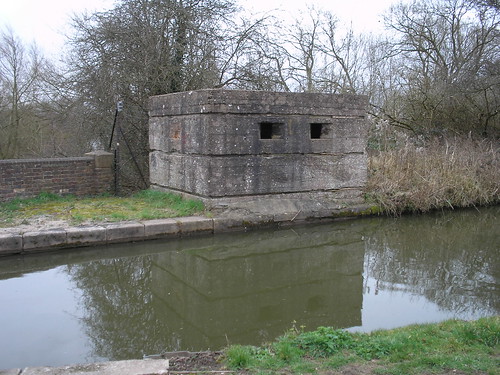In our travels round the system we see quite a few old WWII defence installations. I have always threatened to look them up to see what I could find out. And now I have. Only in 1940 did they set up the Directorate of Fortifications and Works (FW3) to design a range of pillboxes that could easily and quickly be erected by soldiers or local labour. They were mainly just bullet proof as it was found that the shell of a 2lb anti tank gun could find its way through 2 feet of reinforced concrete.
They were mainly formed by pouring concrete between wooden shuttering with reinforcing bars in the middle. Some have been found to contain scrap steel. This may be where all the church railings etc went to! There was inevitably a degree of making it up on the spot and designing them to fit the location, or using the materials at hand so they are not all standard.
The photos below are just the ones I have taken photos of this year but hopefully seeing these will open your eyes to the complexity of the topic and also realise that despite the numbers that may have been constructed their numbers are dwindling year by year. So much so that many are now becoming Listed Buildings.
This is a Type 24 which is hexagonal. The walls were usualy on bullet proof at 12" thick but other versions were made shell proof with thicker walls, sometimes known as a Type 29! Inside was a room divider like a 'Y' that prevented ricochets in the interior. The embrasures were for rifles or light machine guns. This one is on the Trent and Mersey Canal near the River Dove Aqueducts.
The rear of the Type 24 has the longest wall at 14' with an embrasure each side. These are actually the most numerous still existing as there are 1724 recorded. This is the back of the One above.
This one is on the Coventry Canal guarding the Tame Aqueduct. I can not fit this into any category as it it has only two small embrasures to the north and one to the east.

It is a listed a Grade II Listed building and all it says in the listing is that it was built in 1940!
This is a a Type 26, about 10' square with a gun port in each wall. This is actually the prefabricated variant where concrete was poured between shuttering but it wasn't reinforced and then just slotted into concrete posts. Their other name was the 'Stent' after the Stent Precast Concrete Company and as only about 140 of the Type 26 exist, including the Stent, they are quite rare but two or three can be seen from the Oxford canal south of Napton.
This is a Type 28A pill box and is found near to Day's Lock on the Thames. This is the largest pill box as the 28A was enlarged in length to allow extra room for an infantry chamber and another forward facing embrasure. This was supposed to make it less vulnerable to a frontal attack. and is the only one that was specifically designed to withstand shells as the walls are about 42" thick. The main embrasure was able to take a 2lb anti tank gun. There are only 209 Type 28A boxes still surviving.





No comments:
Post a Comment